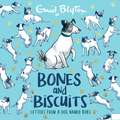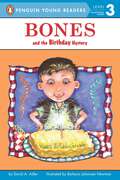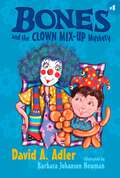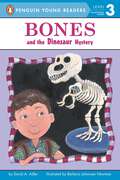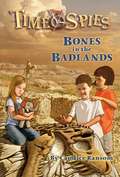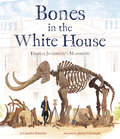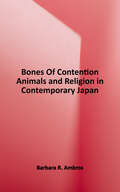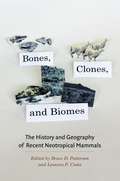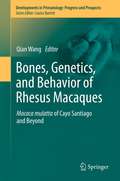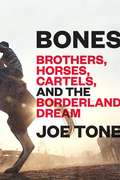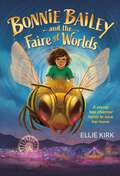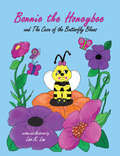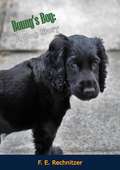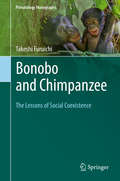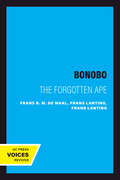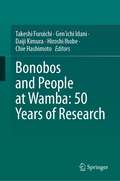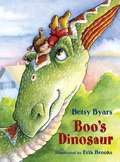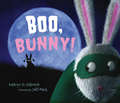- Table View
- List View
Bones and Biscuits: Letters from a Dog Named Bobs
by Enid Blyton"Bones and biscuits! If a cheeky bird didn't fly down to my nose and eat a crumb off my left whiskers! Really, people have no manners at all these days!" In this very funny book, Bobs gives us his opinions on everything from fireworks to frogs, cats to Christmas, in his own words. This illustrated collection of his letters takes us through a year in the life of Bobs, the adored pet terrier owned by national treasure Enid Blyton. Written by Enid Blyton every week to entertain young readers in the 1920s-40s, these have never been published together in book form before. The perfect gift for readers of any age, from 7 to 97, who love dogs and funny stories.(P)2020 Hodder & Stoughton Limited
Bones and the Birthday Mystery (Bones #5)
by David A. AdlerBones and his parents got Grandpa a special present for his birthday. But by the time they all make it to the party, the gift is gone. How could it have disappeared so quickly? Will detective Jeffrey Bones be able to solve the mystery and sing ?Happy Birthday? to Grandpa?
Bones and the Clown Mix-Up Mystery (Bones #8)
by David A. AdlerDetective Jeffrey Bones is having fun eating cake and watching a clown perform tricks at his friend's birthday celebration. But when the clown can't find her street clothes at the end of the party, it's up to Bones to solve this Easy-to-Read mystery!
Bones and the Dinosaur Mystery (Bones #4)
by David A. AdlerDetective Jeffrey Bones solves crimes?but this time it?s personal. He?s at a science museum when his blue Tyrannosaurus rex goes missing. Could someone have stolen it? Bones must find his T-rex! Hopefully there?s something in Bones?s detective bag that can help him solve this roar of a mystery!
Bones in the Badlands (Timespies #2)
by Candice RansomWhen Alex, Mattie, and Sophie touch the spyglass, they find themselves hurtled back to 1898, where real-life dinosaur cowboy Walter Granger has a job for them. Granger has discovered a secret cache of dinosaur skeletons. But someone's trying to steal the bones for himself. Can the Time Spies catch the thief before the spyglass sends them home?
Bones in the White House: Thomas Jefferson's Mammoth
by Candice RansomA little-known, fascinating story about Thomas Jefferson and his obsessive quest to find America's first complete mastodon skeleton.Thomas Jefferson: Third president of the United States. Author of the Declaration of Independence. Obsessive prehistoric mammal hunter?? It's true! In this little-known slice of American history, see Thomas Jefferson as never before!In the late 1700's, America was a new nation, with a vast west that held age-old secrets: Bones! Massive tusks and enormous animal skeletons were being discovered and Thomas Jefferson - politician AND scientist - was captivated. What were these giant beasts? Did they still roam on American soil? Jefferson needed to find out. Funding explorers, including the famed Lewis and Clark, Jefferson sought to find a complete prehistoric mastodon skeleton - one which would advance the young science of paleontology, but would also put this upstart young country on the world stage. Follow along on the incredible journey - full of triumphs and disappointments, discoveries and shipwrecks, ridicule and victory.Author Candice Ransom researched this amazing story for years before telling this tale, closely collaborating with Jefferson scholars and natural history experts. Jamey Christoph's moody, luminous illustrations paint the scene: A young country, a president with a thirst for knowledge, and an obsessive, years-long quest to find the prehistoric bones that would prove the importance of a growing nation.
Bones of Contention: Animals and Religion in Contemporary Japan
by Barbara R. AmbrosSince the 1990s the Japanese pet industry has grown to a trillion-yen business and estimates place the number of pets above the number of children under the age of fifteen. There are between 6,000 to 8,000 businesses in the Japanese pet funeral industry, including more than 900 pet cemeteries. Of these about 120 are operated by Buddhist temples, and Buddhist mortuary rites for pets have become an institutionalized practice. In Bones of Contention, Barbara Ambros investigates what religious and intellectual traditions constructed animals as subjects of religious rituals and how pets have been included or excluded in the necral landscapes of contemporary Japan. <p><p>Pet mortuary rites are emblems of the ongoing changes in contemporary Japanese religions. The increase in single and nuclear-family households, marriage delays for both males and females, the falling birthrate and graying of society, the occult boom of the 1980s, the pet boom of the 1990s, the anti-religious backlash in the wake of the 1995 Aum Shinrikyō incident―all of these and more have contributed to Japan’s contested history of pet mortuary rites. Ambros uses this history to shed light on important questions such as: Who (or what) counts as a family member? What kinds of practices should the state recognize as religious and thus protect financially and legally? Is it frivolous or selfish to keep, pamper, or love an animal? Should humans and pets be buried together? How do people reconcile the deeply personal grief that follows the loss of a pet and how do they imagine the afterlife of pets? And ultimately, what is the status of animals in Japan? Bones of Contention is a book about how Japanese people feel and think about pets and other kinds of animals and, in turn, what pets and their people have to tell us about life and death in Japan today.
Bones, Clones, and Biomes: The History and Geography of Recent Neotropical Mammals
by Bruce D. Patterson Leonora P. CostaAs explorers and scientists have known for decades, the Neotropics harbor a fantastic array of our planet’s mammalian diversity, from capybaras and capuchins to maned wolves and mouse opossums to sloths and sakis. This biological bounty can be attributed partly to the striking diversity of Neotropical landscapes and climates and partly to a series of continental connections that permitted intermittent faunal exchanges with Africa, Antarctica, Australia, and North America. Thus, to comprehend the development of modern Neotropical mammal faunas requires not only mastery of the Neotropics’ substantial diversity, but also knowledge of mammalian lineages and landscapes dating back to the Mesozoic. Bones, Clones, and Biomes offers just that—an exploration of the development and relationships of the modern mammal fauna through a series of studies that encompass the last 100 million years and both Central and South America. This work serves as a complement to more taxonomically driven works, providing for readers the long geologic and biogeographic contexts that undergird the abundance and diversity of Neotropical mammals. Rather than documenting diversity or distribution, this collection traverses the patterns that the distributions and relationships across mammal species convey, bringing together for the first time geology, paleobiology, systematics, mammalogy, and biogeography. Of critical importance is the book’s utility for current conservation and management programs, part of a rapidly rising conservation paleobiology initiative.
Bones, Clones, and Biomes: The History and Geography of Recent Neotropical Mammals
by Bruce D. Patterson and Leonora P. CostaAs explorers and scientists have known for decades, the Neotropics harbor a fantastic array of our planet’s mammalian diversity, from capybaras and capuchins to maned wolves and mouse opossums to sloths and sakis. This biological bounty can be attributed partly to the striking diversity of Neotropical landscapes and climates and partly to a series of continental connections that permitted intermittent faunal exchanges with Africa, Antarctica, Australia, and North America. Thus, to comprehend the development of modern Neotropical mammal faunas requires not only mastery of the Neotropics’ substantial diversity, but also knowledge of mammalian lineages and landscapes dating back to the Mesozoic.Bones, Clones, and Biomes offers just that—an exploration of the development and relationships of the modern mammal fauna through a series of studies that encompass the last 100 million years and both Central and South America. This work serves as a complement to more taxonomically driven works, providing for readers the long geologic and biogeographic contexts that undergird the abundance and diversity of Neotropical mammals. Rather than documenting diversity or distribution, this collection traverses the patterns that the distributions and relationships across mammal species convey, bringing together for the first time geology, paleobiology, systematics, mammalogy, and biogeography. Of critical importance is the book’s utility for current conservation and management programs, part of a rapidly rising conservation paleobiology initiative.
Bones, Genetics, and Behavior of Rhesus Macaques: Macaca Mulatta of Cayo Santiago and Beyond (Developments in Primatology: Progress and Prospects)
by Qian WangForeword by Phillip V. Tobias The introduction of rhesus macaques to Cayo Santiago, Puerto Rico in 1938, and the subsequent development of the CPRC for biomedical research, continues its long history of stimulating studies in physical anthropology. The CPRC monkey colonies, and the precise demographic data on the derived skeletal collection in the Center's Laboratory of Primate Morphology and Genetics (LPMG), provide rare opportunities for morphological, developmental, functional, genetic, and behavioral studies across the life span of rhesus macaques as a species, and as a primate model for humans. The book grows out of a symposium Wang is organizing for the 78th annual meeting of the American Association of Physical Anthropologists to be held in April 2009. This symposium will highlight recent and ongoing research in, or related to, physical anthropology, and reveal the numerous research opportunities that still exist at this unusual rhesus facility. Following an initial historical review of CPRC and its research activities, this book will emphasize recent and current researches on growth, function, genetics, pathology, aging, and behavior, and the impact of these researches on our understanding of rhesus and human morphology, development, genetics, and behavior. Fourteen researchers will present recent and current studies on morphology, genetics, and behavior, with relevance to primate and human growth, health, and evolution. The book will include not only papers presented in the symposium, but also papers from individuals who could not present their work at the meeting due to limitations in the maximum number (14) of permitted speakers.
Bones: Brothers, Horses, Cartels, and the Borderland Dream
by Joe ToneThe dramatic true story of two brothers living parallel lives on either side of the U.S.-Mexico border—and how their lives converged in a major criminal conspiracy José and Miguel Treviño were bonded by blood and a shared vision of a better life. But they chose different paths that would end at the same violent crossroads—with considerable help from the FBI and an enigmatic, all-American snitch. José was a devoted family man who cut no corners in his pursuit of the American dream. Born in Nuevo Laredo, a Mexican border town on a crucial smuggling route, José was one of thirteen children raised by a hardworking ranch hand. He grew up loving the sprawling countryside and its tough, fast quarter horses, but in search of opportunity he crossed the border into Texas to look for work as a bricklayer. He kept his nose clean. He stayed out of trouble. Back in Mexico, José’s younger brother Miguel was leading a different life. While José struggled to make ends meet, Miguel ascended to the top ranks of Los Zetas, a notoriously bloody drug cartel—his crimes had become the stuff of legend and myth on both sides of the border. He was said to have burned rivals alive, murdered Mexican and American law enforcement officers, and launched grenades at a U.S. consulate. José, married with kids and now a U.S. citizen, gave every indication of rejecting his brother’s criminal lifestyle. Then one day he showed up at a quarter-horse auction and bid close to a million dollars for a horse—the largest amount ever paid for a quarter horse at an auction. The humble bricklayer quickly became a major player in the quarter-horse racing scene that thrived in the American Southwest and Mexico. That caught the attention of an eager young FBI agent named Scott Lawson. He enlisted Tyler Graham, an American rancher who would eventually breed José’s champion horse—nicknamed Bones—to help the FBI infiltrate what was revealing itself to be a major money-laundering operation, with the ultimate goal of capturing the infamous Miguel Treviño. Joe Tone’s riveting, exquisitely layered crime narrative, set against the high-stakes world of horse racing, is an intimate story about family, loyalty, and the tragic costs of a failed drug war. Compelling and complex, Bones sheds light on the perilous lives of American ranchers, the morally dubious machinery of drug and border enforcement, and the way greed and fear mingle with race, class, and violence along America’s vast Southwestern border. Advance praise for Bones “One magnificent piece of border reporting.”—Sam Quinones, author of Dreamland: The True Tale of America's Opiate Epidemic “Bones is a riveting read that transcends the larger-than-life cartels, cowboys, and fast horses at its heart. It’s about how hard it is to determine what makes a good guy and a bad guy along our embattled border.”—Joe Drape, author of the New York Times bestseller American Pharoah “What a cast of characters: a bloodthirsty Mexican drug lord, his unassuming blue-collar brother, a daring Texas rancher, and an idealistic young FBI agent. And then there are the racehorses, as fast as the wind, competing for million-dollar purses on the quarter-horse tracks of the American Southwest. Through amazingly detailed research, Joe Tone has brought us a riveting tale about the pursuit of justice in the most dangerous of worlds.”—Skip Hollandsworth, author of the New York Times bestseller The Midnight Assassin
Bonita (The Puppy Place #42)
by Ellen MilesCharles and Lizzie Peterson love puppies. Their family fosters these young dogs, giving them love and proper care, until they can find the perfect forever home. Lizzie is shocked to see that Aunt Amanda has returned home from her vacation to Puerto Rico with an injured puppy. Bonita is a street dog with a hurt leg. Lizzie and her friends decide to raise the money for the puppy's operation. Will Lizzie be able to help this sweet dog?
Bonita's Bugs (Fountas & Pinnell Classroom, Guided Reading)
by Zack Adair Charles LehmanNIMAC-sourced textbook. Bunches of Bugs. Bonita loves bugs. She has them on her cup, her boots, and her hat. She also has bugs in her garden. Find out where Bonita's garden bugs like to be!
Bonnie Bailey and the Faire of Worlds
by Ellie KirkJoin Bonnie Bailey as she enters a magical, world-traveling Faire in this epic middle-grade fantasy about finding your own strength. Thirteen-year-old Bonnie Bailey comes from a long line of beekeepers. But her family&’s apiary is failing, and Bonnie and her mom need money fast if they have any chance of saving it. When a mysterious woman appears among the beehives and offers Bonnie a job at a fair that's in town for one night only, Bonnie reluctantly takes a chance. But the Faire of Worlds isn&’t a regular carnival—she&’s a sentient, magical being who exists in a nomadic pocket reality. Her residents are people and creatures rescued from countless other realities. Bonnie is swept into a world of unimaginable wonders and dangerous undercurrents. She tends a colony of giant bees, befriends a young cowboy who&’s on the run for stealing eggs from flying turtles, and discovers that not everything at the Faire is as happy as it seems. When the Faire is threatened by dark forces, Bonnie faces an impossible decision: return to the safety of her own reality—or stay and fight to protect this fantastical world she has grown to love. With a cast of unforgettable characters and boundless curiosities, Bonnie Bailey and the Faire of Worlds will lure readers back again and again.
Bonnie the Honeybee and The Case of The Butterfly Blues
by Lori K LeeBonnie the Honeybee is blue because she would rather be a beautiful butterfly. With Mama Bee's help, Bonnie discovers that beauty comes in all different shapes and sizes. Author Lori K. Lee uses this adorable character to help children understand that we are all different yet beautiful and special in our very own way.
Bonny's Big Day
by James HerriotThe unforgettable and endearing story of farmer John Skipton and his old carthorse Bonny. Though the mare has been "retired" from farm work for years, Farmer Skipton visits her every day. When veterinarian James Herriot suggests that Bonny be entered in the Darrowby Fair Pet Show, Farmer Skipton is shocked at first. But when the Fair arrives, the surprise will be on everyone else. Once again, James Herriot has fashioned another captivating story about the bond between people (even gruff old farmers) and their animals. With Ruth Brown's illustrations capturing the rugged beauty of the Yorkshire Dales and the colorful site of a country fair, Bonny's Big Day is another treat for the new generation of Herriot fans.
Bonny's Boy: A Dog Story
by F. E. RechnitzerWhen the sunny and affectionate cocker spaniel Bonny dies while Nat is in the Navy, his younger brother Davy Edwards felt he had to bring up Bonny's one living puppy to make his brother proud. Plenty of action abounds, with the black cocker spaniel eventually entering the National Dog Show at Madison Square Garden!Author F. E. Rechnitzer always had a dog of some sort around—from thoroughbred poodles to pooches—and cockers were one of his favorite breeds, being the proud owner of a pair of Cocker Spaniels himself.This wonderful story, first published in 1946, is beautifully illustrated by English-born artist Marguerite Kirmse—another lifelong dog-lover, whose delightful drawings make the little black cocker seem very natural and lifelike.
Bono: The Amazing Story of a Rescue Cat Who Inspired a Community
by Helen BrownFrom New York Times bestselling author Helen Brown comes a funny and moving account of her life-changing month as a foster mother—to a homeless cat named Bono. When Helen Brown arrived in New York for a much-anticipated visit, a fellow animal lover talked her into fostering a shelter cat. Helen visualized a sweet-natured cuddler who blinked and dozed a lot. What she got at Manhattan’s Bideawee shelter was a wide-eyed and unpredictable Persian with a punked-out haircut and a feisty attitude. Bono had become homeless during Hurricane Sandy, had survived a serious infection, and needed daily medications. As a “special needs” cat, he was an unlikely candidate for adoption. But as affection between them grew, Helen resolved to see that Bono found his forever home. She didn’t know that he would change her life in ways she never dreamed possible and teach her lessons she would cherish ever after. Just as this sweet, beleaguered, and hopeful guy deserved a fresh start, Helen too was ready for new beginnings. And so began a heartwarming, uplifting, lasting kind of love . . . Praise for the works of Helen Brown “A buoyant tale, heartfelt and open.” –Booklist “An absolute must.” —Cat World “Brown gives inspiration with her witty, adventurous story.” —RT Book Reviews “Brown writes eloquently about women, daughters, and felines.” —Kirkus Reviews
Bonobo and Chimpanzee: The Lessons of Social Coexistence (Primatology Monographs)
by Takeshi FuruichiThis book describes the similarities and differences between two species, bonobos and chimpanzees, based on the three decades the author has spent studying them in the wild, and shows how the contrasting nature of these two species is also reflected in human nature. The most important differences between bonobos and chimpanzees, our closest relatives, are the social mechanisms of coexistence in group life. Chimpanzees are known as a fairly despotic species in which the males exclusively dominate over the females, and maintain a rigid hierarchy. Chimpanzees have developed social intelligence to survive severe competition among males: by upholding the hierarchy of dominance, they can usually preserve peaceful relations among group members. In contrast, female bonobos have the same or even a higher social status than males. By evolving pseudo-estrus during their non-reproductive period, females have succeeded in moderating inter-male sexual competition, and in initiating mate selection. Although they are non-related in male-philopatric society, they usually aggregate in a group, enjoy priority access to food, determine which male is the alpha male, and generally maintain much more peaceful social relations compared to chimpanzees. Lastly, by identifying key mechanisms of social coexistence in these two species, the author also seeks to find solutions or “hope” for the peaceful coexistence of human beings."Takeshi Furuichi is one of very few scientists in the world familiar with both chimpanzees and bonobos. In lively prose, reflecting personal experience with apes in the rain forest, he compares our two closest relatives and explains the striking differences between the male- dominated and territorial chimpanzees and the female-centered gentle bonobos."Frans de Waal, author of Mama’s Last Hug - Animal Emotions and What They Tell Us about Ourselves (Norton, 2019)
Bonobo: The Forgotten Ape
by Frans B. de Waal Frans LantingThis remarkable primate with the curious name is challenging established views on human evolution. The bonobo, least known of the great apes, is a female-centered, egalitarian species that has been dubbed the "make-love-not-war" primate by specialists. In bonobo society, females form alliances to intimidate males, sexual behavior (in virtually every partner combination) replaces aggression and serves many social functions, and unrelated groups mingle instead of fighting. The species's most striking achievement is not tool use or warfare but sensitivity to others.In the first book to combine and compare data from captivity and the field, Frans de Waal, a world-renowned primatologist, and Frans Lanting, an internationally acclaimed wildlife photographer, present the most up-to-date perspective available on the bonobo. Focusing on social organization, de Waal compares the bonobo with its better-known relative, the chimpanzee. The bonobo's relatively nonviolent behavior and the tendency for females to dominate males confront the evolutionary models derived from observing the chimpanzee's male power politics, cooperative hunting, and intergroup warfare. Further, the bonobo's frequent, imaginative sexual contacts, along with its low reproduction rate, belie any notion that the sole natural purpose of sex is procreation. Humans share over 98 percent of their genetic material with the bonobo and the chimpanzee. Is it possible that the peaceable bonobo has retained traits of our common ancestor that we find hard to recognize in ourselves?Eight superb full-color photo essays offer a rare view of the bonobo in its native habitat in the rain forests of Zaire as well as in zoos and research facilities. Additional photographs and highlighted interviews with leading bonobo experts complement the text. This book points the way to viable alternatives to male-based models of human evolution and will add considerably to debates on the origin of our species. Anyone interested in primates, gender issues, evolutionary psychology, and exceptional wildlife photography will find a fascinating companion in Bonobo: The Forgotten Ape.
Bonobos and People at Wamba: 50 Years of Research
by Takeshi Furuichi Gen'Ichi Idani Daiji Kimura Hiroshi Ihobe Chie HashimotoThis book reviews all the findings about bonobos and the local people of Wamba village in the Luo Scientific Reserve in the Democratic Republic of the Congo over the last 50 years. In 1973, Takayoshi Kano, a Japanese primatologist, traveled across a vast area of the Congo Basin with a bicycle and found Wamba village to be a promising site to start his first studies on wild bonobos. Since then, many researchers from Japan and all over the world have been working at Wamba, now the longest standing study site, to uncover various aspects of the ecology and behavior of this most recently identified great ape species. The researchers study bonobo behaviors and carry out various activities for the conservation of bonobos. They also conduct anthropological studies of local people who live with bonobos and believe them to be distant relatives from the same family, living in the forest. This book is published in commemoration of 2023 marking the 50th year of study. The main chapters are contributed by active researchers studying bonobos and the local people at Wamba. The book also includes contributions from various eminent researchers who have carried out short-term research or have supported research at Wamba, which helps place these studies of bonobos in a broader primatological or anthropological perspective. This book will be a useful resource for professional researchers in primatology and anthropology, as well as graduate or undergraduate students interested in these research fields.
Bonzo's War: Animals Under Fire 1939 -1945
by Clare CampbellWhat was it like to be a dog or cat when the world was at war? When food was rationed and cities were bombed? Pets (on the whole) do not write memoirs, so to find the answer to that question, Clare Campbell went in search of voices of those people whose lives were entwined with animals.She found stories - inspiring and harrowing - of animals under fire, of evacuated and homeless pets, of brave animals who provided comfort to humans while the bombs fell. Of pets unwittingly entangled in war, like the Dunkirk pets and the camp followers who switched sides to stay alive; and the 6,000 dogs recruited by the British Army - loaned for duty by their families - many never to return. Meanwhile with food in short supply, government officials launched a ruthless campaigns against pets... Thoroughly researched and deeply moving, Bonzo's War gives a fascinating account of, and platform for, the forgotten stories as yet unheard, of the creatures big and small caught up in a human conflict far beyond understanding.
Boo ABC
by J. H. LeeA is for Adorable, B is for Boo! The world's cutest dog takes on the ABCs, and his adventures are more precious than ever. Boo and his best friend Buddy are featured in their favorite situations and places alongside the letters of the alphabet. The ABCs have never been so furry--and fun!
Boo's Dinosaur
by Betsy Byars Erik BrooksAn early chapter book from Newbery Medal winner Betsy ByarsWhen Boo brings home a dinosaur that only she can see, her brother Sammy, doesn't want to encourage her antics. Boo and her dinosaur are inseparable until Boo says good-bye to the dino quite suddenly. When Sammy sees how sad his sister is, he understands Boo's need for her dinosaur more than he wants to admit. So much so that he almost believes it . . . almost. Betsy Byars has written many chapter books, including Little Horse and Little Horse on His Own. Her language, perfectly tailored to beginning readers, combines with Erik Brooks's charming illustrations to make a delightful book for children who are just starting to read. Boo's Dinosaur is a 2007 Bank Street - Best Children's Book of the Year.
Boo, Bunny!
by Kathryn O. Galbraith Jeff MackEeek! Squeak! Halloween can be especially spooky for a shy bunny. But when that shy bunny bumps into another shy bunny, friendship scares away fear. Once they join forces, not even the darkest night can stop them two brave bunnies from having the best Halloween ever.Full of sounds, spookiness, and sweetness, this dynamic picture book celebrates the best part of Halloween: friends!
